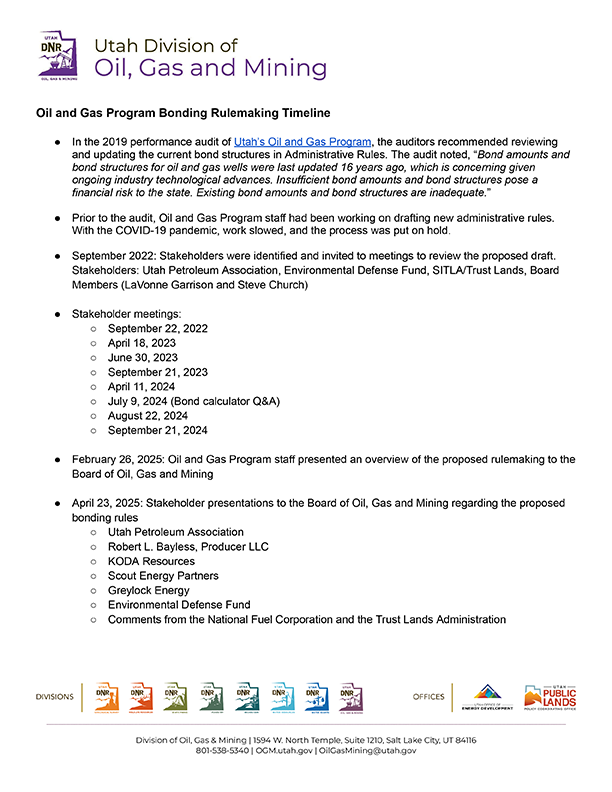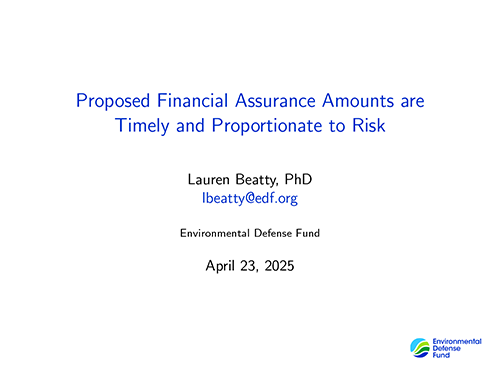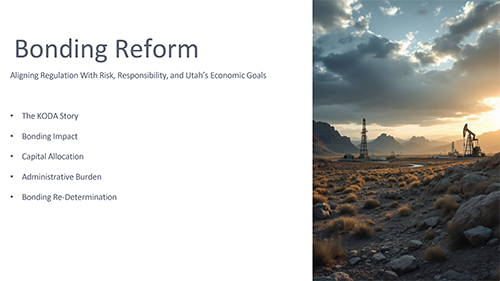What necessitates the creation of a new bond rule by the Utah Division of Oil, Gas and Mining?
The current bond rule is over 20 years old and no longer adequately addresses the increasing costs associated with plugging and abandoning orphan wells. Furthermore, there has been a significant upward trend in the number of documented orphan wells nationally. A 2019 legislative audit also highlighted the need for updated bonding rules to ensure sufficient financial security for the state regarding these fiscal risks, as mandated by Utah Code 40-6-5(9).
What are the primary objectives of the draft bond rule?
The main objectives of the draft rule are to provide Utah operators with better tools to manage their bond amounts, to base the bond amount on operational risks, to reduce the administrative burden for both the industry and regulators, and ultimately to decrease the financial liability of the state concerning orphaned oil and gas wells. It also aims to support a full range of Utah operators by offering specific bond amounts tailored to their operations.
How does the draft bond rule propose to calculate bond amounts for operators?
The draft rule introduces a tiered system for calculating bond amounts, including a Base Bond, a Supplemental Bond, and Individual Bonds. The tier (Tier I, II, or III) is determined by an operator's production level and at-risk well ratio. The Base Bond is calculated based on the total number of bonded wells. The Supplemental Bond takes into account the average true vertical depth (TVD) of at-risk state wells. Individual well bonds are calculated based on the average depth of those specific wells. A bond calculator tool is available to assist operators in determining their bond amounts.
What factors are considered when determining an operator's tier under the proposed bond rule?
An operator's tier is primarily determined by two factors: their production level (measured in Barrels of Oil Equivalent per day - BOE/day) and their at-risk well ratio (the percentage of total qualifying wells that are considered "at-risk"). Tier I generally applies to operators with higher production and a lower at-risk well ratio, while subsequent tiers may apply to those with lower production or a higher at-risk well ratio.
How does the proposed bond rule address the issue of "at-risk" wells?
The proposed bond rule specifically incorporates the concept of "at-risk" wells in the calculation of the Supplemental Bond. This aims to ensure that operators with a higher proportion of wells that are inactive, shut-in, or otherwise considered more likely to become orphaned have a bond amount that better reflects this increased risk. The rule also provides operators with mechanisms to manage their at-risk wells, potentially impacting their bond requirements.
How might the proposed bond rule impact the financial bonding requirements for different operators compared to the current rule?
The draft rule is expected to result in varied changes in bond amounts for different operators. Some operators may see a significant increase in their required bond amounts, while others might experience a decrease. This variability is intended to better align the bond amount with the specific risks associated with each operator's activities, production levels, and number and depth of wells, particularly at-risk wells. Comparisons with current bonding requirements and those of other Rocky Mountain states (Colorado, Wyoming, and New Mexico) show that the proposed Utah rule could lead to both higher and lower requirements for specific operators.
How does the draft bond rule aim to address the growing number and cost of orphan wells in Utah?
By updating the bonding requirements to better reflect the current and projected costs of plugging and abandoning wells, especially orphan wells, the draft rule intends to ensure that sufficient financial resources are available to the state for these activities. The risk-based approach to bonding, particularly the Supplemental Bond component related to at-risk wells, aims to have operators more adequately cover the potential future costs associated with their well inventory.
What provisions does the draft bond rule include to provide flexibility for Utah operators in managing their bonds?
The draft rule aims to provide operators with tools to manage their own bond amounts. This includes allowing operators to manage their production levels, decrease the number of at-risk wells, and potentially petition the Board for bond review. The tiered system and the ability to calculate bonds based on specific operational variables offer a more flexible approach compared to the older, less dynamic rules.





